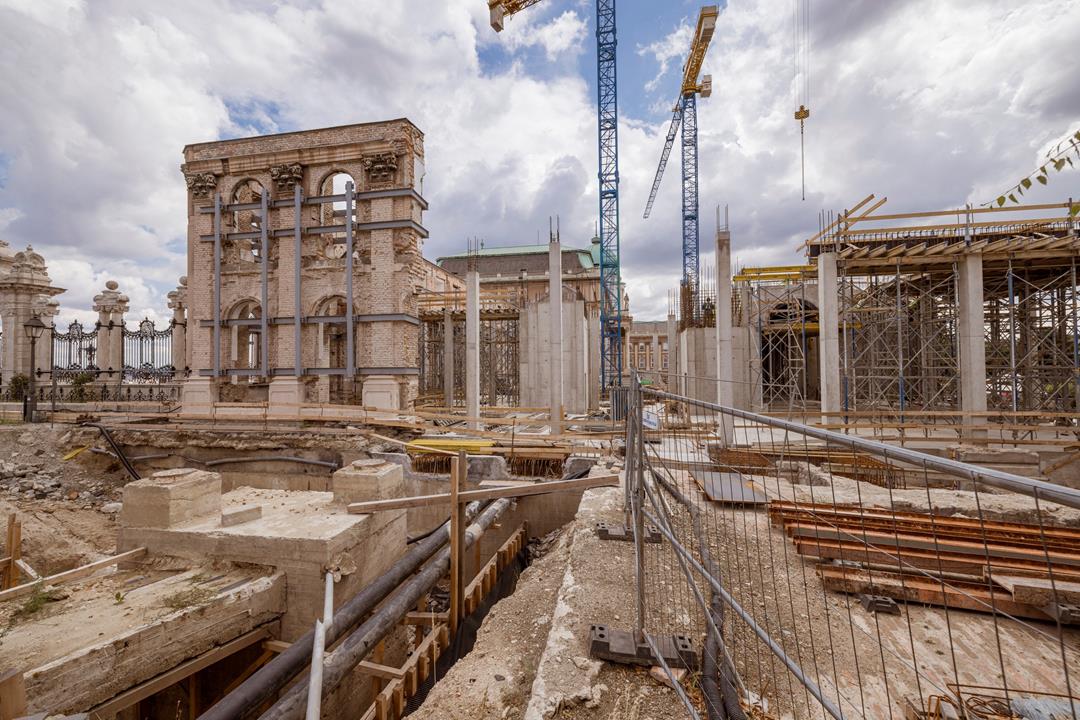PHOTOS: Buda Castle’s northern wing is rising once more, recreating its pre-WWII grandeur

According to both official commitments and visual plans, the northern wing of Buda Castle will soon resemble its pre-siege appearance from the Second World War. The National Hauszmann Programme aims to restore the Buda Castle to its former grandeur, as it stood at the turn of the 19th and 20th centuries. To accomplish this, all but one wall of the northern wing has been demolished and is now being reconstructed using reinforced concrete. Here’s a preview of the ongoing progress.
Buda Castle and the Royal Palace are being rebuilt
A long-standing objective of successive Orbán administrations has been the restoration or reconstruction of as many buildings in the Buda Castle District as possible—structures left in ruins after the Second World War due to a lack of funding. Few people realise that Budapest endured the third-longest siege of the war, after Leningrad (now St Petersburg) and Stalingrad (now Volgograd). The toll was devastating—not only in terms of civilian and military casualties, but also in the destruction of architectural heritage. The Royal Palace itself (then the residence of Governor Miklós Horthy), along with much of the Buda Castle District, fell victim to this devastation.
In the ensuing communist era, there was neither the financial capacity nor political will to return these buildings to their original condition.

The Orbán governments have remained committed to restoring these areas to what they interpret as their state at the turn of the century. Among the many projects undertaken are the renovation of the former Carmelite Monastery—now housing the Prime Minister’s Office—and the reconstruction of the former Ministry of Defence headquarters. However, the restoration of the Royal Palace stands as the most ambitious project to date, encompassing numerous related structures and historical monuments—a vast initiative that has steadily unfolded over the past decade.
- As a cultural landmark, the Magdalene Tower is reopening.
Here’s what the northern wing is expected to look like upon completion:


It is worth noting that Alajos Hauszmann, appointed lead architect of the Buda Castle palace in 1891, paid little attention to the medieval ruins beneath the new structure. That oversight led to the April discovery of a deep cellar from a 14th–15th century noble residence, revealing invaluable artefacts including ancient coins.
- Archaeologists discover stunning relics during renovation.
Northern wing of the Buda Castle being rebuilt using reinforced concrete
Following WWII, minimal effort was made to restore the Royal Palace to its original form. For instance, it was given a roof vastly different from the ornate, historicist original. According to experts, the palace’s northern wing was completely destroyed, leaving only a single wall from the Hauszmann era—this section has been preserved, while the remainder has been demolished.

Design renderings suggest that the wing is being faithfully reconstructed to reflect its pre-war appearance—albeit using reinforced concrete. According to a post by the National Hauszmann Programme, construction is progressing on schedule, adhering to modern building codes while incorporating traditional architectural techniques. Structural work is currently underway, along with the production of decorative elements.
- After 100 years, the famed gate will soon be visible again at Buda Castle.




Model pieces of ornamentation have already been completed, and specialists are now producing interior elements such as faux-marble finishes and gypsum stucco decorations. The team has finalised the colour, texture, and materials for the external plasterwork. Craftsmen are also fabricating limestone skirting and decorative features, cast iron elements, wrought-iron sconces and lighting fixtures, as well as the structural framework of the Jungfer Gate. Copper and ornamental sheet-metal works for the roof are also in progress.
Completed elements include the ground-floor exhibition hall and the vaulted ceiling of a future café space on the first floor. The project’s goal is not merely to replicate the palace’s visual appearance but to reflect its historical construction materials and craftsmanship.

According to the programme’s latest update, the aim is for the northern wing to regain its “original massing, richly decorated façade, and former dynamic roofline.” The building will once again link Szent György Square with the Hunyadi Courtyard. Key interior spaces will also be reinstated, including the vestibule, enclosed courtyard, coat-check lobby, and the historic Munkácsy Hall.
Explore more of our architecture articles.
To read or share this article in Hungarian, click here: Helló Magyar







